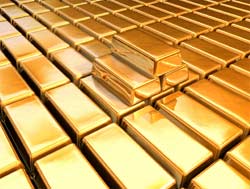Investments in gold soar 248 per cent in Q1
20 May 2009
The total tonnage demand for gold recorded 1,016 tonnes, up a strong 38 per cent in the first quarter of 2009 from last year. In dollar value terms, this represented a 36 per cent rise to $29.7 billion, according to data released today by World Gold Council (WGC).
Demand for gold as the biggest source of investment rose 248 per cent in the Q1 to 596 tonnes from 171.3 tonnes in Q1 2008, which includes exchange traded funds (ETF), bars and coins. The total investment off-take reached 711.2 tonnes, up 173 per cent on the levels of a year earlier.
 Gold demand soared in the first quarter as the metal provided a safe haven for investors, even while it was shunned as jewellery due to the ongoing global economic crisis. Traditionally, gold is seen as a safer investment in times of crisis, and also a means to safeguard against future inflation.
Gold demand soared in the first quarter as the metal provided a safe haven for investors, even while it was shunned as jewellery due to the ongoing global economic crisis. Traditionally, gold is seen as a safer investment in times of crisis, and also a means to safeguard against future inflation.
The gold price averaged $908.41 during Q1 was down 2 per cent on the Q1 2008 average. This is relatively flat result in dollar terms as it masks a significant gains in local currency terms for consumers in several key countries, including India and Turkey.
The data revealed that exchange traded funds was the main contributor to the quarterly inflow totalling 465.1 tonnes, up 540 per cent on 72.7 tonnes a year earlier at a value of $13.6 billion. Gold bar and coin demand was the biggest driver of investment in the second half of 2008, marking a major change in pattern of investment .
Gold bar and coin demand remained extremely strong during Q1 with net retail investment rising 33 per cent year on year to 130.8 tonnes. The large positive investment came from the western markets while de-hoarding was noticed in non-western markets as prices had peaked in some countries and investors wanted to cash in on their profits.
The de-hoarding was driven largely by two countries where investors wanted to cash in on their profits - India (-17.0 tonnes) and Thailand (-19.9 tonnes). India, traditionally the world's largest gold market, saw demand declining considerably under pressure from record rupee prices. The demand dropped 83 per cent from a level a year earlier.
The single biggest contributor to the inflows globally Q1 was Germany, where demand rose 400 per cent to 59 tonnes from the 1Q of 2008, was mainly due to safeguard against future inflation.
The only two non-western markets which recorded higher levels of bar hoarding than in Q1 2008 were China and Hong Kong.
Jewellery off-take in the Middle Eastern region fell 26 per cent, more or less in line with global demand.
The jewellery demand in Q1 was down 24 per cent than a year earlier. Most countries suffered a decline as consumers responded to the high gold price (record levels in some countries) and consumer spending on non-essential items such as jewellery had been hit hard by the economic recession. The only countries to record positive growth were China and Hong Kong.
Gold demand in industrial and dental applications slumped 31 per cent in Q1 2009 to just 80.2 tonnes as the global economic crisis impacted severely on all segments of demand.
Electronics off-take, the key component of industrial demand, plummeted 36 per cent as consumer demand evaporated, while gold used in the other industrial & decorative sector slipped 24 per cent, chiefly as the result of a near 70 per cent decline in Indian off-take.
"There has been a seismic shift away from capital appreciation towards wealth preservation and we believe this trend will define investment behaviour in the next decade, said Aram Shishmanian, CEO of World Gold Council.
.webp)

.webp)


.webp)

























